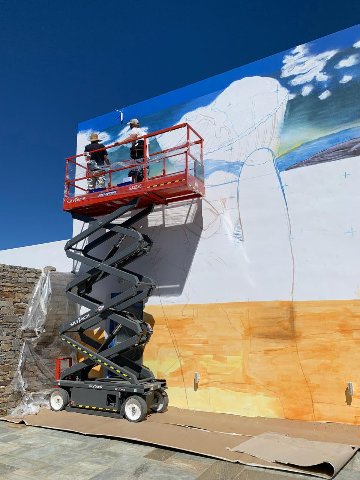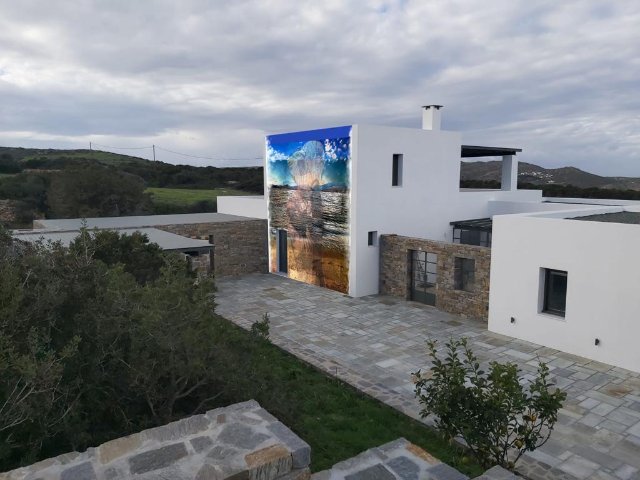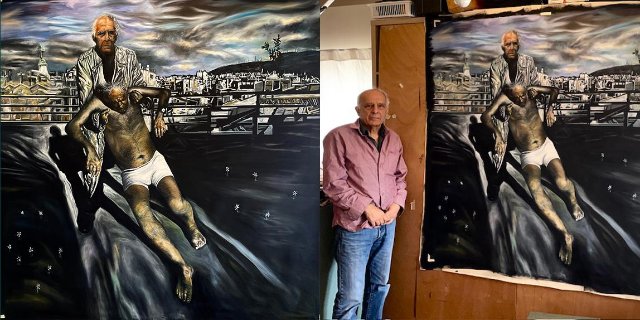Rafael Mahdavi Paints a Mural
On the Cycladic Island of Paros
By: Charles Giuliano - May 30, 2024
Charles Giuliano Describe the site for this work. How did you come to be there?
Rafael Mahdavi The wall for the mural is part of a friend’s house on the Cycladic Island of Paros. I spend my summers there. I first met Frank at my first solo painting show in NYC at the Tibor de Nagy Gallery in 1973. Frank and I stayed in touch, he liked my work. Last year he commissioned the mural. Seven by seven meters
CG Who commissioned the work? Can you tell me something about "Frank?"
RM Frank is a Canadian collector who first bought my work when I was doing my first pieces on light-sensitive canvas in the mid-1970s in Paris.
CG What were the challenges in creating this work?
RM I first did a modelo/collage, about A2 size, which Frank approved. Like in all such projects, including theatre sets, there were logistical issues. (I might add here that, to earn a living, I had done scenery painting for the theatre and opera in New York, Paris, and Rome in the 60s, 70s.) How much paint to order for the 50 square meters? Where to rent a cherry-picker for two and have it delivered? The heat was not an issue. We wore hats. For me at least, creativity is never a problem, that’s the easiest part. There was also the steep learning curve for me of accepting that on that large scale the size of details is relative. You have to choose how much detail is even visible on such a scale
CG What was the role of your assistant Leonidas Giannakopoulos?
RM I couldn’t have done the mural without Leonidas, a well-known muralist in Greece. I learned that there is a thriving culture of muralists and urban/grafitti artists world-wide. Outdoor murals rarely last more than 12 years, which gives this urban culture a gutsy and daring quality, not usually connected with the museum curators. Museums are more and more aware of urban murals and there are also festivals of this dynamic movement. Most muralists also paint on transportable canvases and have gallery shows.
CG How was the paint applied? It looks like airbrush. How did you prepare the surface? Did it entail gesso or a sealing surface?
RM The wall surface was smooth concrete painted white with heavy-duty outdoor paint. The finished mural was mat-varnished with a special tough varnish against sun, salt in the air, UV rays, humidity and rain, even hail. The paint was applied with “scrub-grit” brushes, those used to clean tiled floors, one-inch and five-inch flat brushes, and acrylic spray paint in cans with adjustable nozzles.
CG In 1924 two versions of the Surrealist Manifesto were published, the more renowned one by Andre Breton. Your mural easily is defined as surrealist. Discuss your feelings about that tradition and why it is still relevant to you a century after its inception.
RM Surrealism was and remains an important element of modern and contemporary art, morphing sometimes into Dada and pop. I will add though that the surrealists were sexist, the lot of them, and beyond the nymphet-muse aspect women were not taken seriously. This subject clearly opens a can of worms. The second thing I will say is that André Breton was a brilliant writer but a ruthless “pope” slinging extraditions and excommunications right and left. Aragon, a great poet I’ll admit and the second founder of the movement, was a dyed-in-the-wool Stalinist, had a seat on the French Communist Party presidium and was married to Elsa Triolet, the sister in-law of Mayakovsky. And Aragon’s behavior vis à vis the Spanish Republicans fleeing Franco’s forces was despicable and cowardly. I have always had a hard time for falling for the Romantic belief in the separation of the creative mind from the moral one. Surrealism is important for me because it insists that painting is more than visual grammar, it deals with visual triggers which go deep and beyond––beyond what? There you are, look around at the world.
CG Your next exhibition will be a solo show at the American Foundation, large works, at the Cité Universitaire in Paris in September. What does that entail and describe the latest works?
RM The seven paintings in this show will all be 63” x 63”, oil on canvas. The central piece will be the pietá I painted for my brother who died last December at age 76 in Prague.
I know Paris well. I speak French fluently. It is the toughest and meanest and rudest city I have ever known, and today unless you are a trust fund baby you can forget about going to the City of Light to pursue your dreams. I wasn’t a trust fund kid. I survived and it wasn’t at the Ritz sipping martinis with wannabe writers. I was lucky and survived because were no computers in the sixties and seventies. I lived under the radar, illegally as hell. There wasn’t much fraternité or égalité, but liberté ran rampant.
As to the paintings, they have to do with camouflaged meanings in cadavres exquis (a drawing game on folded paper the surrealists invented and played), trompe-l’oeil stuff, flowers (geraniums were my mother’s favorite), a landscape in Burgundy a seascape in the Greek Islands, Diogenes my favorite philosopher...
A final caveat, I am a painter, and a craftsman. Only time and luck will tell if some of my paintings end up in the realm of art. It’s a long shot. It always is.





